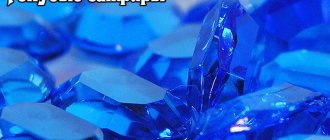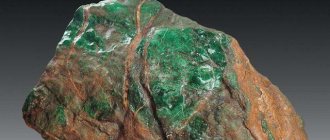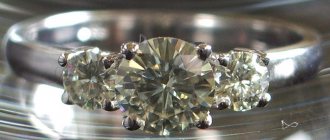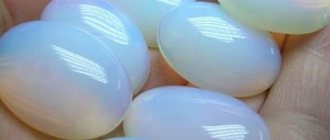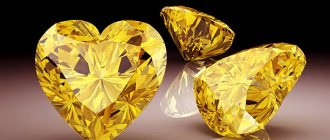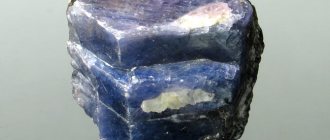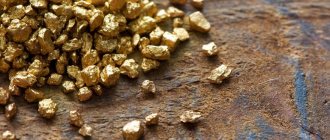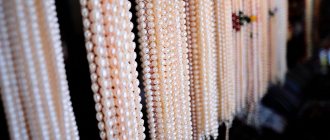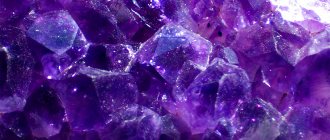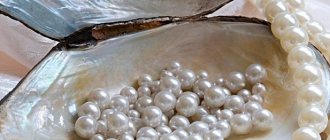Sapphires of rich pink or blue color are not found in nature as often as jewelry lovers would like. Therefore, the cost of such stones is very high and not everyone can afford it. This issue was resolved by creating an artificial analogue of the mineral. What is hydrothermal sapphire, how to distinguish it from natural one and what zodiac sign it is suitable for, we will consider below.
Types and colors of stone
Initially, synthetic laboratory stones, like natural stones, are colorless (leucosapphires). By adding impurities, the desired color can be achieved. Synthetic sapphire shades and additives:
- blue, blue, violet, cornflower blue – iron and titanium;
- pink, red, burgundy, orange-pink – vanadium, chromium, titanium;
- green – chrome tourmaline;
- white – no impurities;
- yellow – beryllium.
Scientists have learned to grow synthetic star sapphire. These are stones that have an asterism effect - if you look through it into the light, you get the impression that there are clusters of stars inside.
Changing the shade or improving the appearance of a gem is aimed at increasing its cost and commercial qualities. This is done through various influences:
- Diffusion is the ability of some substances to penetrate into the composition of other compounds, replacing the original molecules. The crystals are treated with beryllium salts under high pressure and temperature, resulting in an enhanced asterism effect. Such stones are called diffusion stones.
- Ultraviolet irradiation makes the color richer and thicker. This is a refined sapphire.
- Heating to 1500–2000 °C. This is also a method of refining a gem, in which the color of the mineral changes, for example, from pink to blue.
Diffusion and refined sapphires are very similar to natural minerals; only an experienced jeweler can suspect the treatment.
Separately, there is declassified sapphire - a mineral of natural origin, but of low quality, which is why it cannot be assigned to any specific class in terms of transparency or color. Opaque, with dark inclusions, nondescript, it does not look like the usual beautiful crystal.
View this post on Instagram
Posted by Jewelermag (@uvelirmag) Jul 9, 2021 at 2:29 PDT
Other imitations of natural corundum
Synthetic corundum is a structural analogue of a natural crystal, but differs from it in the chemical composition and content of microimpurities. From an aesthetic and practical point of view, it is the most acceptable copy of natural sapphire.
Natural imitations of opaque sapphire include specimens obtained from waste natural stones by gluing or pressing. This group also includes colored natural minerals of other rocks.
Cheap fakes are made from glass alloys, which contain metal oxides to obtain the desired color.
Opaque stones are imitated using colored plastics.
History of the invention of stone
Sapphire is a rare find in nature, its reserves are limited. Known since ancient times, the stone remains popular to this day. By the end of the 19th century, the problem became acute. This required replenishing the jewelry market with new jewelry.
Many chemists and physicists dealt with the issue of creating artificial stone. As a result, in 1907, Verneuil managed to grow a crystal under artificial conditions. To do this, he used aluminum oxide and a torch flame. Synthetic sapphires are still produced in laboratories using the Verneuil method.
Useful tips
You should choose jewelry with sapphires based on your own preferences and financial capabilities. Those who believe in the magical and healing properties of stones should purchase real gems. It is believed that only they have supernatural powers. When purchasing natural stone, you should ask the seller for documents confirming its authenticity.
People who value, above all, an attractive appearance and the absence of flaws in stones, are more suitable for artificial sapphires. Purchasing jewelry with such corundum is a good option for those who want to save money.
Method of making sapphire
There are 2 ways to obtain synthetic sapphire in the laboratory:
- A mixture of starting materials (aluminum oxide and color additives) in powder form is poured into a vibrating hopper with special holes. The powder spills into the furnace through tubes from the holes, while oxygen and hydrogen are supplied at the same time. When hydrogen burns, it melts the mixture and a crystal begins to grow.
- Nano-sapphires are grown using aluminum oxide as a base. To do this, the seed plates are placed in special devices where the required pressure and temperature up to 5000 °C are maintained.
Watch a program about growing stones in a special factory:
Characteristics
Standard characteristics are used to assess the quality of synthetic sapphires. The better the color, clarity, cut and weight of the stone, the higher it will cost.
Color
Color is the most important characteristic of sapphire. In mineralogy, sapphire itself is called blue corundum. The cost is affected not only by the shade, but by the intensity of the color and its lightness.
The most famous shades are Royal Blue and Kashmir cornflower blue. Cornflower blue stones have a silky shine and seem to glow from within.
Dark blue sapphires, reminiscent of Australian ones, are not very highly valued. The same can be said about light blue stones.
Sapphires of fancy colors are also used in jewelry. Modern synthesis methods make it possible to create stones:
- yellow;
- green;
- orange-pink (padparadscha);
- kunzite (purple);
- with alexandrite effect - color change depending on the lighting;
- two-color - with a clear transition boundary between different colors in the stone.
The presence of an asterism (ray star) or color changing effect increases the cost of sapphire: such stones are rare in nature, and therefore are in great demand among jewelers.
Grown RusGems sapphires in fancy colors
Purity
Sapphires may contain inclusions and cracks. Most of them are invisible to the naked eye and therefore do not affect the visual perception of the stone. By the nature and location of the inclusions, you can determine the origin of the sapphire, as well as find out by what method it was obtained.
Corundums synthesized by the Verneuil method often contain gas bubbles and cracks. Sapphires obtained by the Czochralski method are purer.
Weight
Pure natural sapphires over 5 carats are rare and very expensive. The larger the sapphire, the higher its cost per carat.
Existing synthesis methods make it possible to grow corundums of sufficiently large size. For example, the mass of a crystal synthesized by the hydrothermal method can reach 240 carats. The Czochralski method produces sapphires weighing 10 thousand carats or more.
Cut shape
As a rule, sapphires are given a facet cut. It ensures uniform reflection of light and enhances inner radiance. The most popular forms:
- "circle";
- "oval";
- "pear".
Synthetic sapphires do not limit the craftsman when choosing a cut shape. When working with natural materials, he has to take into account the characteristics of the stone - inclusions, microcracks, defects, so the shape is not standard. Synthetic corundum does not impose these restrictions: the stone can be given any shape.
Sapphires with asterism effect are cut in cabochons. This is the only way to reveal all the beauty of the ray star located in the center of the stone.
Synthetic sapphire RusGems in octagon cut
How to distinguish a sapphire from a fake
It is quite difficult to distinguish a synthetic stone from a natural one by external signs:
- laboratory crystal is particularly clean, transparent, larger than natural crystal and cheaper;
- artificially grown sapphires often have a growth zone - a stripe inside the crystal, characterized by a more saturated color;
- the natural mineral has irregularities and cracks;
- small round bubbles are a sign of growing in an autoclave.
You can find the difference between a natural crystal grown in the natural environment and one grown in the laboratory using mechanical methods:
- Illuminate with a UV lamp. A natural gem fluoresces in red or orange, while a synthetic gem does not glow at all.
- A refractometer determines the refractive index of light in a stone. For a natural crystal it is 1.762–1.776.
- If you place the mineral in monobromonaphthalene and place the container on a white sheet, then straight stripes will indicate natural growth of the stone, and beveled ones will indicate artificial growth.
Under the guise of sapphire, the market may offer to buy fakes made of painted glass. You can distinguish a sapphire from a fake at home:
- Natural minerals contain inclusions - these are light dots and lines that are visible when examining the stone through a magnifying glass. Laboratory specimens do not have inclusions, but they are much more expensive than glass fakes. Fake glass does not have any traces of impurities.
- The gem is highly hard and therefore resistant to mechanical damage. If you run it across the glass, the stone will scratch it.
- Natural stone is cool, and laboratory stone is at ambient temperatures. Both take quite a long time to warm up from the warmth of their palms. The glass heats up quickly in your hands.
By the designations on jewelry tags you can determine what kind of material was used to create the jewelry:
- the number of crystals is indicated by the 1st digit;
- the next designation is the name of the gem, sapphire is indicated as “Sp.”;
- if the following is “Ob.”, then the stone has been refined, that is, it has been exposed to high temperature or x-ray irradiation to change the shade;
- abbreviation "Kor." indicates hydrothermal corundum;
- the next line tells about the shape of the cut (Pear – “Gr.”, square – “Sq.”, Triangle – “Tk.”);
- 3rd line – purity, weight and color; hydrothermal stones do not have such characteristics; these numbers will not appear on the tags of synthetic gems.
Pay attention to the video about the differences between natural and synthetic stones:
What it is?
A natural gem takes millions of years to form in a specific environment. The price for it is sky-high, but the demand is still good.
Natural minerals are formed in the earth's crust due to certain geological operations that are interconnected in time and space.
Water, high temperature and powerful pressure form ore veins. They serve as places for accumulations of various crystals. Sapphire deposits also contain liquid gases that circulate in a closed space for many years.
In laboratories for the creation of nanominerals, scientists recreated natural conditions. But it takes several months for the grown crystal to be of decent size. Nano sapphires grow faster and are therefore cheaper than their natural counterparts. The cost of artificial stones is lower, but not so much as to compare them with ordinary glass. The purity and depth of color of artificial crystals is better than that of genuine minerals. Hydrothermal sapphire does not require additional refining, like a stone with genuine properties. These methods, by the way, are expensive and require additional investment.
Artificial sapphire is a type of corundum. It is also the basis for rubies and emeralds. The blue color of sapphires comes from titanium and iron. Heated beryl also participates in the synthesis. Taking into account the production conditions, we can say that synthetic stone is not grown, but cooked. The base of one of the mixtures is aluminum oxide, which looks like an ordinary white substance. It will turn into sapphire only at a temperature of 2200 degrees Celsius. The crystallization rate of artificial sapphires is 4 mm per hour. Large crystals require a lot of time. Subsequently, if necessary, they are cut into pieces and processed, making them resemble natural deposits.
Properties and applications of artificial sapphire
Tons of crystals are produced every year. A significant portion of synthetic sapphires is used in jewelry. The other part is used to create:
- substrates for microcircuits;
- glass for the aviation industry, space objects;
- camera parts;
- slides;
- inserts in ophthalmic devices;
- glasses for watches, gadgets.
The chemical formula of hydrothermal sapphire is Al2O3. Physical properties:
- hardness – 9 points out of 10 on the Mohs scale;
- melting point – 2030 °C;
- pronounced glass luster;
- cut only with diamond;
- density 3.93 g/cm3.
- dissolves in acids and organic compounds.
Jewelry with mineral
A variety of jewelry is made from synthetic sapphire:
- rings;
- tiaras;
- rings;
- necklace;
- pendants;
- brooches
The synthetic gem is distinguished by its bright colors and shine, has a noble appearance, and therefore requires the selection of an outfit. Light crystals look good on young girls, dark-colored stones look good on middle-aged women and men. Jewelry with a miniature insert is suitable for daily wear, while larger gemstones will be appropriate for going out. Examples of combinations of synthetic sapphire with wardrobe items:
- coffee evening low-cut dress, updo and blue necklace;
- pale pink classic suit with silver shimmer and pink earrings in silver;
- blue jeans, white blouse and purple bracelet;
- summer dress in boho style and green pendant in gold;
- burgundy jacket, black trousers and white brooch.
View this post on Instagram
Posted by Elsa_Anticolly_ (@elsa_anticolly_) Mar 18, 2021 at 1:47 am PDT
View this post on Instagram
Posted by Elsa_Anticolly_ (@elsa_anticolly_) Nov 9, 2021 at 10:39 PST
How to care for and store stone
Synthetic crystals are strong and durable and require care:
- The mineral is not prone to contamination; it should be washed 2-3 times a year. To do this, clean the crystal with a brush and baby soap, then rinse with warm running water. Wipe dry.
- Store separately from other jewelry. Due to its high strength, a synthetic gem can scratch and split them.
- Avoid prolonged exposure to direct sunlight. The product will become dull.
- The decoration must not be thrown or dropped. Despite the strength, microcracks appear in the stones, which leads to its destruction. Chips on the surface spoil the appearance.
To watch a video review of jewelry with this stone:
Post-cultivation treatment
To prevent cracking, the resulting sapphires are subjected to post-growth annealing in special installations. Subsequently, they are given the desired shape using laser grinding and polishing with suspensions and pastes. Due to the fragility of the material, processing using lathes, drilling and grinding machines is not used.
Synthetic sapphires are colored and refined using various technologies: diffuse treatment with metal salts, heating, and ultraviolet irradiation.
